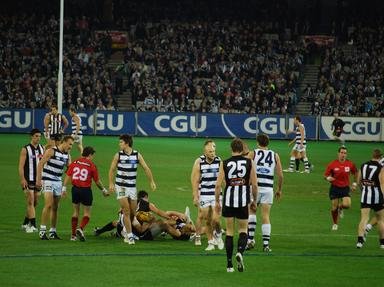Quiz Answer Key and Fun Facts
1. The impetus for the creation of the game of Australian Rules Football came from members of which drawn out sporting discipline?
2. In the early days of Australian Rules Football what was the time limit of a single game?
3. International Rules Series is a hybrid of Australian Rules Football that Australia contests with which other country?
4. Are Australian Rules Football players allowed to throw the ball?
5. Maxwell Smart would have a good idea, but what was the longest suspension dished out by the Australian Rules Football Tribunal during the twentieth century?
6. The Australian Football League adopted that name in 1990. What was it called prior to that?
7. What was unusual about Fitzroy's winning of the Australian Rules Football Grand Final of 1916?
8. A top level game of Australian Rules Football was once stopped by a pig.
9. The Sydney Swans also wear the epithet "Bloodstained Angels". With this in mind, which of the following represents their team colours?
10. In Australian Rules Football full forwards attract attention because they tend to kick the most goals. Which spearhead, with no connection to Lady Godiva, was the first in the AFL to kick 1,000 goals?
Source: Author
pollucci19
This quiz was reviewed by FunTrivia editor
gtho4 before going online.
Any errors found in FunTrivia content are routinely corrected through our feedback system.
